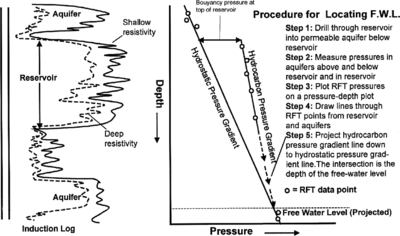Difference between revisions of "Free water level determination using pressure"
FWhitehurst (talk | contribs) m (FWhitehurst moved page Finding free-water level using pressure to Free water level determination using pressure: most important term first) |
Cwhitehurst (talk | contribs) m (added Category:Treatise Handbook 3 using HotCat) |
||
| (4 intermediate revisions by 2 users not shown) | |||
| Line 6: | Line 6: | ||
| part = Critical elements of the petroleum system | | part = Critical elements of the petroleum system | ||
| chapter = Formation fluid pressure and its application | | chapter = Formation fluid pressure and its application | ||
| − | | frompg = 5- | + | | frompg = 5-27 |
| − | | topg = 5- | + | | topg = 5-28 |
| author = Edward A. Beaumont, Forrest Fiedler | | author = Edward A. Beaumont, Forrest Fiedler | ||
| link = http://archives.datapages.com/data/specpubs/beaumont/ch05/ch05.htm | | link = http://archives.datapages.com/data/specpubs/beaumont/ch05/ch05.htm | ||
| Line 19: | Line 19: | ||
[[file:formation-fluid-pressure-and-its-application_fig5-12.png|400px|thumb|{{figure number|1}}Easy method for determining free-water level (FWL) by projecting RFT pressure data downward from a reservoir to the aquifer.]] | [[file:formation-fluid-pressure-and-its-application_fig5-12.png|400px|thumb|{{figure number|1}}Easy method for determining free-water level (FWL) by projecting RFT pressure data downward from a reservoir to the aquifer.]] | ||
| − | An easy method for determining free water level (FWL) is projecting RFT pressure data downward from a reservoir to the aquifer. [[:file:formation-fluid-pressure-and-its-application_fig5-12.png|Figure 1]] illustrates the procedure. | + | An easy method for determining free water level (FWL) is projecting [[Wireline formation testers|RFT]] pressure data downward from a reservoir to the aquifer. [[:file:formation-fluid-pressure-and-its-application_fig5-12.png|Figure 1]] illustrates the procedure. |
==Procedure using a single measurement== | ==Procedure using a single measurement== | ||
| − | The | + | The list below outlines the procedure for determining the free water level using a single [[Pressure_transient_testing#Pressure_drawdown_and_buildup_tests|pressure buildup]] point in the reservoir. |
| − | + | # Determine [[buoyancy pressure]] (''P''<sub>b</sub> ) at the depth of the measured pressure (P<sub>m</sub> ) from the measured pressure: | |
| − | + | #*:<math>P_{\rm b} = P_{\rm m} - P_{\rm hydrostatic}</math> | |
| − | + | # Determine buoyancy pressure gradient (''P''<sub>bg</sub> ): | |
| − | + | #*:<math>P_{\rm bg} = P_{\rm hydrostatic\ pressure\ gradient} - P_{\rm hydrocarbon\ pressure\ gradient}</math> | |
| − | + | # Calculate downdip length of [[hydrocarbon column]] (''h''): | |
| − | + | #*:<math>h = \frac{P_{\rm b}}{P_{\rm bg}}</math> | |
| − | |||
| − | |||
| − | :<math>P_{\rm b} = P_{\rm m} - P_{\rm hydrostatic}</math> | ||
| − | |||
| − | |||
| − | |||
| − | |||
| − | |||
| − | :<math>P_{\rm bg} = P_{\rm hydrostatic\ pressure\ gradient} - P_{\rm hydrocarbon\ pressure\ gradient}</math> | ||
| − | |||
| − | |||
| − | |||
| − | |||
| − | |||
| − | :<math>h = \frac{P_{\rm b}}{P_{\rm bg}}</math> | ||
| − | |||
| − | |||
As an example, let's determine the downdip length of a 30°API oil column with the following givens: | As an example, let's determine the downdip length of a 30°API oil column with the following givens: | ||
| Line 78: | Line 61: | ||
[[Category:Critical elements of the petroleum system]] | [[Category:Critical elements of the petroleum system]] | ||
[[Category:Formation fluid pressure and its application]] | [[Category:Formation fluid pressure and its application]] | ||
| + | [[Category:Treatise Handbook 3]] | ||
Latest revision as of 17:54, 17 February 2022
The free water level occurs where buoyancy pressure is zero in the reservoir-aquifer system. It defines the downdip limits of an accumulation. Pressure data reliability affects the resolution; however, resolution improves when it is supplemented with other petrophysical information.
Procedure: using repeat formation tester (RFT) data[edit]
An easy method for determining free water level (FWL) is projecting RFT pressure data downward from a reservoir to the aquifer. Figure 1 illustrates the procedure.
Procedure using a single measurement[edit]
The list below outlines the procedure for determining the free water level using a single pressure buildup point in the reservoir.
- Determine buoyancy pressure (Pb ) at the depth of the measured pressure (Pm ) from the measured pressure:
- Determine buoyancy pressure gradient (Pbg ):
- Calculate downdip length of hydrocarbon column (h):
As an example, let's determine the downdip length of a 30°API oil column with the following givens:
- Pm = pressure::3555 psi at depth::7611 ft
- Phydrostatic = 3525 psi
- Phydrostatic pressure gradient = 0.465 psi/ft
- Phydrocarbon pressure gradient = 0.38 psi/ft
Answer (tied back to steps above):
Therefore, the free water level is at depth::8167 ft.
See also[edit]
- Static hydrocarbon pressure gradients
- Estimating static oil pressure gradients
- Estimating static gas pressure gradients
- Plotting the hydrocarbon pressure gradient






